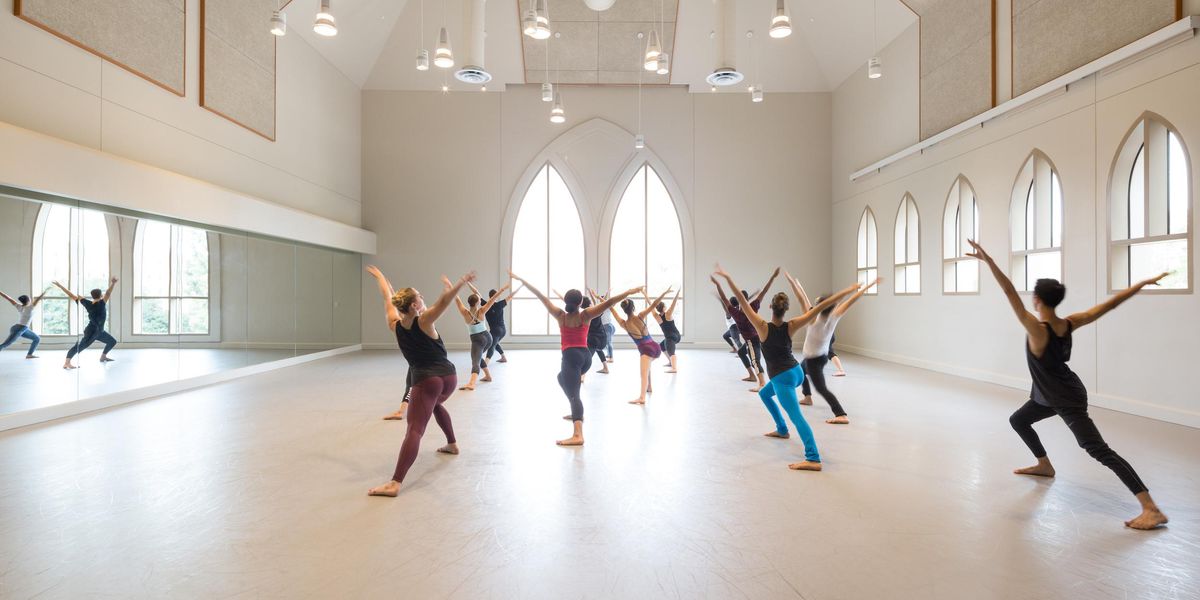Centerwork: A Two-Way Street
CityDance paves the way for students and pros to collaborate.
CityDance students and members of Hubbard Street 2 warm up for a dress rehearsal. Photo: Theo Kossenas/Media 4 Artists, Courtesy CityDance.
“Pronounciate your feet,” Taryn Kaschock Russell declared to 28 of CityDance’s ballet students last fall during a master class in the airy North Bethesda, Maryland, studio. Russell meshed “pronounce” and “enunciate” into her own portmanteau to emphasize the clarity she wanted to see in the petit allégro. “I want you to fly,” she encouraged the students, some as young as 11, others seniors in high school. Then in sock-clad feet she hitched up her warm-up pants and precisely demonstrated the speed and ballon she was seeking. Breathless, the black-and-pink––clad ballet students tried it again. Then again.
Russell, director of Hubbard Street 2, the second company of the acclaimed troupe Hubbard Street Dance Chicago, spent a brief three-day residency at the suburban Washington, DC, studio, where she and HS2 dancers taught both master classes and repertory and, most unusually, shared the stage with the high-school–aged dancers in a program featuring three works from the semi-professional company and eight showcasing the students of CityDance’s Conservatory/Select program.
Among the numerous pre-professional studios in the Washington, DC, region, CityDance has in just a few short years built a reputation as an alternative to dance studios that focus solely on ballet training or on a regimen of competitions. While it’s still too soon to track alumni from the program, students are being accepted into some of the nation’s most prestigious college dance programs, from Ailey/Fordham to SUNY Purchase.
“We have a lot of talented young people here,” said Lorraine Spiegler, artistic director of studio education for the school and conservatory. Many, she explained, find their way to CityDance when they’ve outgrown or don’t quite fit into their home studio. She said: “In our institution students don’t primarily come from one area or another. They come from ballet, hip-hop, the competition world; they come out of tiny little studios and larger, well-established ballet programs. At CityDance, they seek to understand what contemporary dance is and they can discover what it will mean to be a contemporary dancer.”
Founded in 1996, CityDance rose to acclaim as a repertory company that performed works by an impressive range of choreographers, including Doug Varone, Kate Weare, Sophie Maslow, and even Paul Taylor. The school came about after the company, and in 2005 became a partner in the Music Center at Strathmore’s education wing. Last year, though, the school eclipsed the company, which after years of touring internationally under the direction of Paul Gordon Emerson, folded up shop.
CityDance has more than 500 children enrolled this year, 120 of whom are in the competitive Conservatory/Select program, which offers performing opportunities and weekly master classes every Saturday for the studio’s pre-professional dancers ages 11 to 19. Recent or upcoming guest artists include members of Evidence, Complexions, and La La La Human Steps. That experience of a new teacher each week acclimates students to pick up unfamiliar material quickly and without fear, readying them for the world of auditions early in their careers.
The HS2 residency scheduled for the fall was unusual. Together, Russell and Spiegler agreed to share a bill, presenting three HS2 works and a selection of solo and group works from the CityDance student repertoire. Both organizations, Spiegler explained, are committed to seeking out and supporting new choreographic voices. Spiegler often hires young talent to create works on her students, and HS2 runs an annual choreography competition to expand the field.
Russell saw the brief residency (which occurred in the aftermath of Hurricane Sandy) as an opportunity for her dancers. “I love to give HS2 as many performing opportunities as possible,” she said. “I love that there’s some integration [between the two groups]. I don’t know that this exact model will go forward as something we might pursue, but I’m looking at what’s going to be most enriching for a residency.”
In this case, she saw success. The CityDance students got to take master classes and learn repertory from the HS2 dancers. The HS2 dancers got a chance to try out their own recently learned rep onstage, but, more important, Russell noted, they got the opportunity to lead classes and teach.
She pointed out that the HS2 dancers were only about four or five years older than some of the CityDance students. “Anytime they’re able to teach and they have that interaction in the front of the room,” Russell said, “I feel that that only brings inspiration for them when they go onstage.”
HS2 dancer Alicia Delgadillo taught a solo to a room full of attentive teens. While she now performs it regularly, Delgadillo first learned it as a high schooler when she was attending a HS2 summer intensive. She says that if she could go back and talk to her high school self, “I would say, ‘Get out of your head and just dance.’ ” That’s exactly what she hopes these students, who have the technical chops—legs that brush past ears, triple turns, and split leaps—can glean from her. The CityDance students dance at a high level technically; they are learning to rein in their energy and harness their emotions onstage.
Russell said that she wouldn’t be surprised if she were to cross paths with some of the CityDance students in coming years. “There’s no question that some of these dancers could be completely inspired by this experience and could find their way to us. I would welcome that.”
Lisa Traiger, a former president of Dance Critics Association, writes on dance from Rockville, MD.




